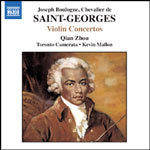
Saint-Georges: Violin Concertos No. 1, Op. 3 and Nos. 2 and 10
 $25.00
Out of Stock
$25.00
Out of Stock6+ weeks add to cart
JOSEPH BOULOGNE SAINT-GEORGES
Saint-Georges: Violin Concertos No. 1, Op. 3 and Nos. 2 and 10
Qian Zhou (violin) / Toronto Camerata / Kevin Mallon, conductor
[ Naxos / CD ]
Release Date: Sunday 12 September 2004
This item is currently out of stock. It may take 6 or more weeks to obtain from when you place your order as this is a specialist product.
"This music is certainly worth an airing ... it is beautifully played and a joyful listening experience ... an irresistible bargain"
(MusicWeb Sept 2004)
"The works on this second volume of the Toronto Camerata's series stand comparison with early Mozart, and the ensemble play suavely yet lightly. Much of Qian Zhou's playing is similarly stylish… An excellent recording."
-- Anna Picard, The Independent on Sunday, 29/08/04
"This music is certainly worth an airing ... it is beautifully played and a joyful listening experience ... an irresistible bargain"
(MusicWeb Sept 2004)
"Perhaps the finest work here is the D major Concerto, Op 1 No 3. Qian Zhou plays with a lovely singing tone and Mallon directs with flair."
-- Stephen Pettitt, The Sunday Times, 29/08/04
In an age of remarkable individuals Joseph Boulogne, le Chevalier de Saint-Georges occupies a unique position as an athlete, violin virtuoso and composer. The son of a French colonial planter and a beautiful Senegalese slave, Joseph Boulogne was born near Basse Terre, Guadeloupe, and lived for some time on an estate on St Domingue before his family finally settled in Paris in around 1749. In his early teens Saint-Georges became a pupil of the famous master of arms La Boëssière and also had riding lessons with Dugast at the Tuileries. He fought his first public fencing match in Paris with Giuseppe Gianfaldoni on 8th September 1766 and, although he lost, his opponent predicted that Saint-Georges would become the finest swordsman in Europe.
Virtually nothing is known about the musical education of Saint-Georges, although early accounts of his life claim that he had lessons with Platon, his father's plantation manager on St Domingue, and it has been suggested that he later studied violin with Leclair and composition with Gossec in France. As the six years he spent in La Boëssière's establishment were devoted exclusively to physical training and academic studies it has been assumed that the bulk of his musical education took place between 1758 and 1769, the year of his first professional engagement, as a violinist in Gossec's Concert des Amateurs. It seems more than likely that Gossec encouraged Saint-Georges's ambitions as a composer and may have offered him professional advice even if no formal pupil-teacher relationship existed. Saint-Georges made his public début as a soloist with the Concert des Amateurs in 1772, performing his two violin concertos Op. 2. When Gossec became a director of the Concert Spirituel in 1773, Saint-Georges succeeded him as musical director and leader of the Amateurs which rapidly won recognition as one of the finest orchestras in France.
Tracks:
Violin Concerto in D major, Op. post., No. 2
Violin Concerto No. 10 in G major
Violin Concerto in D major, Op. 3, No. 1
